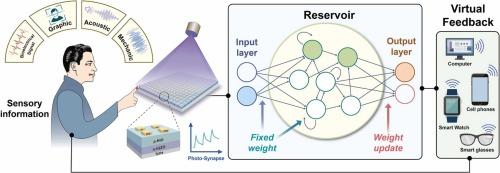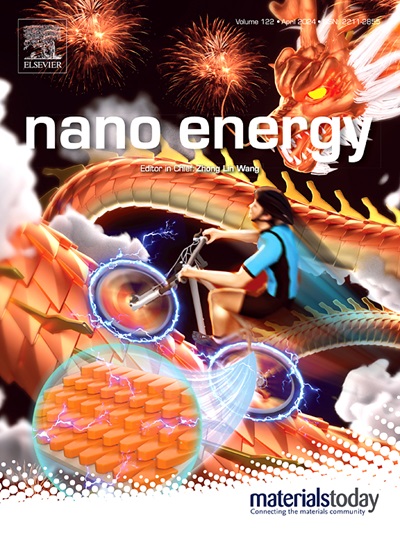用于静态和动态库计算的自供电光电突触装置
IF 16.8
1区 材料科学
Q1 CHEMISTRY, PHYSICAL
引用次数: 0
摘要
自供电光电储层计算为高效计算提供了强大的解决方案,同时显着降低了功耗,使其成为人工智能和大数据分析中先进实时应用的理想候选者。因此,探索光电突触器件在光库计算中的广泛应用具有重要意义。在这项工作中,我们提出了一种用于光电储层计算的自供电光电突触器件。为了突出该器件的自供电能力和非线性特性,该器件采用了由n型InGaZnO和p型NiO组成的p-n结,使其能够在自供电条件下表现出类似突触的特性,如兴奋性突触后电流、成对脉冲易化和响应光脉冲刺激的短期可塑性。通过创新光电储层计算的数据预处理方法和输入信号方式,成功实现了静态和动态储层计算。在静态储层计算中,该设备的图像分类准确率达到95.2%,在动态储层计算中,语音信号识别准确率达到98.2%,肌电信号分类准确率达到93.5%。这些结果证明了我们的自供电光电突触装置具有更广泛应用的潜力,为实时数据处理和自适应学习系统提供了重大进展。本文章由计算机程序翻译,如有差异,请以英文原文为准。

Self-powered optoelectronic synaptic device for both static and dynamic reservoir computing
Self-powered optoelectronic reservoir computing offers a powerful solution for efficient computation while significantly reducing power consumption, making it an ideal candidate for advanced real-time applications in artificial intelligence and big data analytics. Therefore, exploring the broader application of optoelectronic synaptic devices in optical reservoir computing is of great importance. In this work, we present a self-powered optoelectronic synaptic device designed for optoelectronic reservoir computing. To highlight the device's self-powered capability and nonlinear characteristics, the device features a p-n junction composed of n-type InGaZnO and p-type NiO, enabling it to exhibit synaptic-like properties such as excitatory postsynaptic current, paired-pulse facilitation, and short-term plasticity in response to light pulse stimulation under self-powered conditions. By innovating the data preprocessing methods and inputting signal patterns for optoelectronic reservoir computing, both static and dynamic reservoir computing were successfully realized. In static reservoir computing, the device achieved an image classification accuracy of 95.2 %, while in dynamic reservoir computing, it attained 98.2 % accuracy in spoken signal recognition and 93.5 % in electromyographic signal classification. These results demonstrate the potential of our self-powered optoelectronic synaptic device for broader applications, offering a significant advancement in real-time data processing and adaptive learning systems.
求助全文
通过发布文献求助,成功后即可免费获取论文全文。
去求助
来源期刊

Nano Energy
CHEMISTRY, PHYSICAL-NANOSCIENCE & NANOTECHNOLOGY
CiteScore
30.30
自引率
7.40%
发文量
1207
审稿时长
23 days
期刊介绍:
Nano Energy is a multidisciplinary, rapid-publication forum of original peer-reviewed contributions on the science and engineering of nanomaterials and nanodevices used in all forms of energy harvesting, conversion, storage, utilization and policy. Through its mixture of articles, reviews, communications, research news, and information on key developments, Nano Energy provides a comprehensive coverage of this exciting and dynamic field which joins nanoscience and nanotechnology with energy science. The journal is relevant to all those who are interested in nanomaterials solutions to the energy problem.
Nano Energy publishes original experimental and theoretical research on all aspects of energy-related research which utilizes nanomaterials and nanotechnology. Manuscripts of four types are considered: review articles which inform readers of the latest research and advances in energy science; rapid communications which feature exciting research breakthroughs in the field; full-length articles which report comprehensive research developments; and news and opinions which comment on topical issues or express views on the developments in related fields.
 求助内容:
求助内容: 应助结果提醒方式:
应助结果提醒方式:


